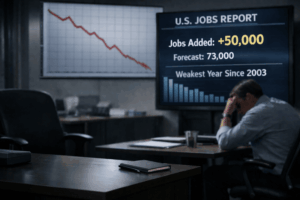Daily News Nuggets | September 9th, 2025 — Here’s what you need to know about today’s most important economic and precious metals news:
Dollar Drops to 7-Week Low, Gold Strikes $3,659
The dollar just hit a seven-week low after disappointing jobs revisions sparked fears about economic weakness and reinforced expectations for aggressive Fed action. Gold responded predictably, jumping to $3,659.10 per ounce —another record that underscores its role as the anti-dollar trade. The jobs data revealed deeper cracks in the labor market than previously thought, with revisions showing fewer positions created over recent months.
It’s a classic playbook: when unemployment concerns rise and rate cut expectations intensify, gold becomes the go-to asset for nervous investors seeking shelter from both currency debasement and economic uncertainty. Expect this trend to accelerate if labor market deterioration continues.
But today’s price jump is just the latest chapter in a much bigger story…
Why Gold Can’t Stop Breaking Records
Gold’s record-breaking rally shows no signs of slowing, with spot prices climbing past previous highs as investors bet the Fed will cut rates soon. The precious metal is benefiting from a perfect storm: a weakening dollar, falling bond yields, and growing expectations that monetary easing is imminent.
Market analysts note that gold’s momentum reflects more than just rate cut speculation — it’s a vote of no confidence in paper currencies. The message is clear: investors are positioning for a major shift in monetary policy that could reshape markets for months to come.
Speaking of that monetary policy shift, the Fed may be rewriting its own rulebook…
Is 3% the New 2%? Fed May Accept Higher Inflation
With the Fed’s September meeting approaching, inflation remains stubbornly above target — and that might not matter anymore. Core CPI sits at 3.1% while the Fed’s preferred PCE measure hovers near 2.9%, both well above the sacred 2% target that’s guided policy for years. Yet rate cuts seem increasingly likely, suggesting the Fed may be quietly accepting a “new normal” of 3% inflation rather than risk economic damage.
This pivot represents a fundamental shift in central banking philosophy: growth over price stability. For gold investors, this tolerance for higher inflation could mean sustained demand as traditional currency loses purchasing power and savers seek alternatives to protect their wealth.
It’s not just individual investors taking notice — the world’s central banks are voting with their vaults…
Historic Shift: Gold Overtakes Treasuries in Reserves
Here’s a stat that’s reshaping how we think about global reserves: Central banks might now hold more gold than U.S. Treasuries for the first time in modern history. The numbers tell a remarkable story — $3.92 trillion in Treasuries versus what’s likely now over $4.2 trillion in gold, thanks to this year’s stunning 40% rally.
While this isn’t about central banks dumping dollars wholesale, it reflects gold’s meteoric rise and sustained official sector buying. The symbolic significance can’t be ignored: in an era of unprecedented money printing and geopolitical tensions, gold is reclaiming its historical role as the ultimate reserve asset — one without counterparty risk or political strings attached.
With demand surging from all corners, the supply side of the equation is also evolving…
Anglo-Teck Merger Reshapes Mining Landscape
Anglo American and Canada’s Teck Resources are creating a mining powerhouse worth over $53 billion through a merger that will rank the combined company among the top five copper producers globally. The deal comes at a critical time for copper markets, with demand surging from electric vehicles and renewable energy infrastructure. Anglo Teck will have its global headquarters in Vancouver, bringing together Anglo’s African and Latin American operations with Teck’s North American assets.
The merger is expected to deliver annual pre-tax synergies of approximately $800 million by the end of the fourth year, primarily through operational efficiencies and procurement savings. But the real prize lies in Chile: their adjacent Collahuasi and Quebrada Blanca copper mines could unlock an additional $1.4 billion in annual revenue synergies from 2030-2049. With copper prices already elevated and supplies tightening, this consolidation positions the new entity to command premium prices in an increasingly supply-constrained market.






